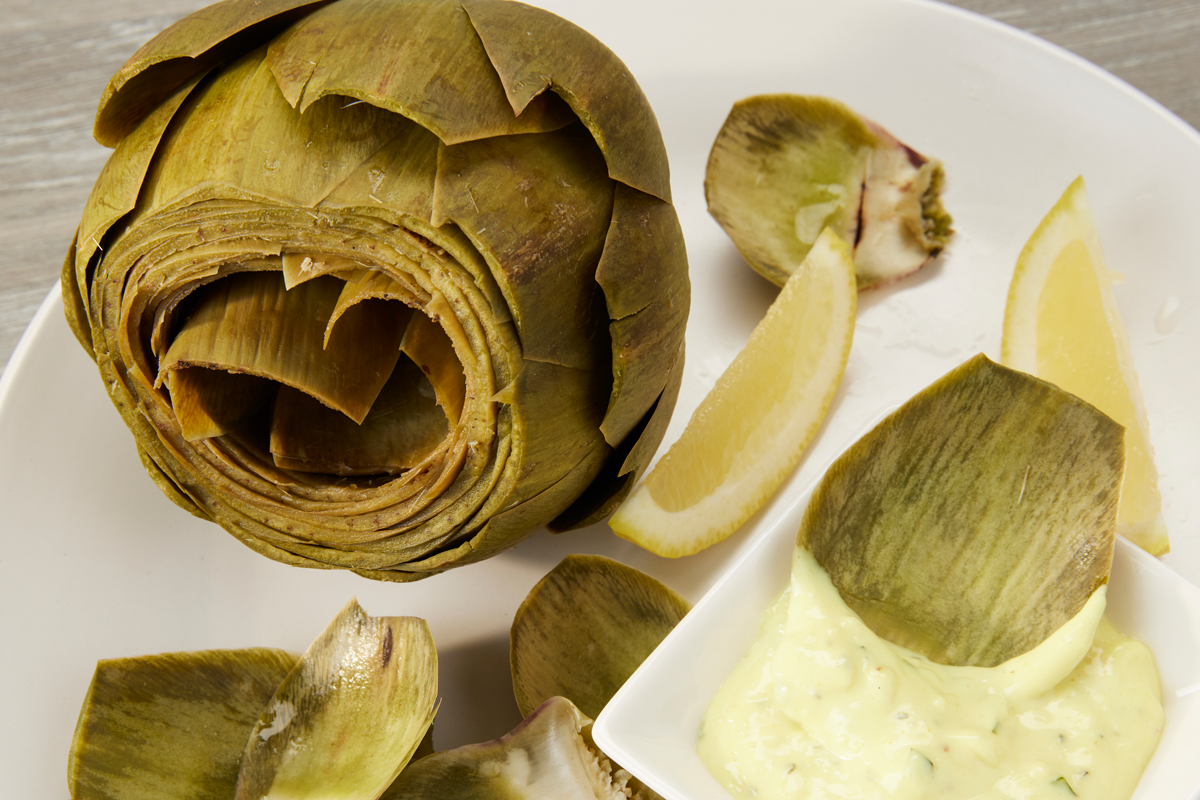
Artichoke lovers know that this delicious vegetable is worth the effort it takes to soften its prickly leaves and to get to the buttery-textured, nutty-flavored central “heart.” Opting for a jar of marinated artichoke hearts is a fine way to enjoy them, too, but with a few tips, preparing fresh, in-season artichokes is easy to do in your own kitchen.
Picking and storing fresh artichokes
An artichoke by nature is prickly. It is the flower bud of a prickly thistle, and its leaves create a thorny protection for the tasty heart at its core. The globe artichoke, which is the most common, can be as large as a softball, but their average size is that of a baseball.
When choosing an artichoke, look for a compact and firm head. Light brown splotches on the leaves and stem are a normal result of cold temperatures or frost before the bud was picked. Just be sure that the artichoke looks moist and fresh, especially where it’s been cut. You can refrigerate a fresh artichoke, unwashed, in a plastic bag for up to five days.
Preparing the artichoke for cooking
After washing and drying the artichoke, use a sharp knife to cut off and discard the top inch to remove the thorny tips. Using a pair of kitchen scissors, cut off any remaining tips closer to the center. Cut the stem off the bottom of the artichoke so that it sits upright, like it will when it’s served on your plate. To avoid the artichoke from turning brown, rub it all over with cut lemon.
Cooking a fresh artichoke
Start with the simplest and most classic preparation: boiling and serving with butter. If you’re feeling even more adventurous, make a flavored butter, adding lemon and garlic, or lemon and herbs, but simple melted butter will do nicely.
Squeeze fresh lemon juice into a pot of salted water and bring to a boil, then add the artichoke and reduce the heat to medium, partially covering the pot with a lid. Boil until a bottom leaf can be easily pulled off, usually around 45 minutes or longer. Then drain and let cool a bit before serving.
Eating the edible parts
With the artichoke standing upright on your plate, start with the leaves, pulling off each one, dipping the tip in melted butter and then scraping off the interior flesh with your teeth before discarding the leaf. Having a large bowl at the center of the table is ideal for the discarded leaves. As you move toward the center of the artichoke, the leaves become softer the closer you get to the hairy choke that covers the artichoke heart. Pull the remaining leaves up and off the artichoke heart. Remove the thorny, center leaves with a fork and discard. Dip the tips of the remaining cluster of edible leaves and enjoy.
Now for the artichoke heart! With a knife, cutting horizontally straight across the top, remove the hairy choke, scooping any remaining hairs away with a spoon. Then, the heart is yours for the taking. Cut into bite-sized pieces, dip in melted butter and savor the most delectable part of the vegetable.
Artichoke recipes: grilling, stuffing, baking, roasting
Now that you’ve got the hang of it, you’ll find that artichokes are ideal for other preparations, such as grilling, stuffing, baking and roasting – all with delicious results.
Need recipe ideas? Find many seasonal recipes for artichokes in our Market recipe collection. Or enjoy the many prepared artichoke choices found throughout your Market Kitchen, Bakery and Meat & Seafood Departments; see the seasonal selection. Yum!
Explore More Topics
Related Posts
- Celebrate Oregon Wine Month, May 2024
May is Oregon Wine Month, thirty-one days dedicated to enjoying Oregon wine, fine dining, boosting our local economy, and getting a healthy dose of dopamine.
- What’s the Deal with Collagen Supplements? Here’s what you need to Know
Improve your skin, hair and joint health with collagen supplements from Market of Choice.
- What Are the Health Benefits of the Mediterranean Diet?
At Market of Choice, we like to keep up with trends in nutrition to ensure we’re providing the foods our community needs to thrive. You’ve no doubt heard or read something about the Mediterranean Diet. No nutritional or health discussion would be on trend without it. Read on for our take on this popular diet, its benefits and advantages.



